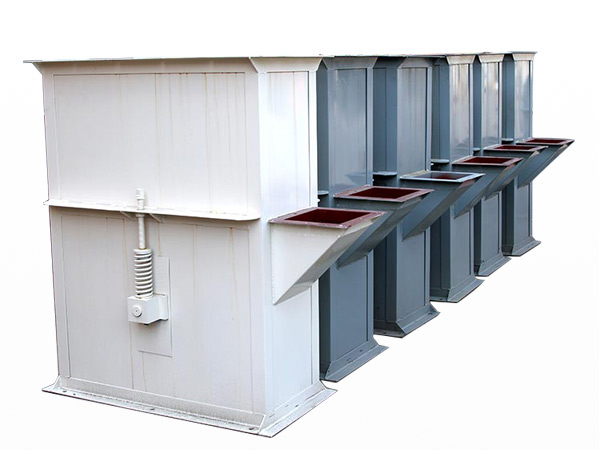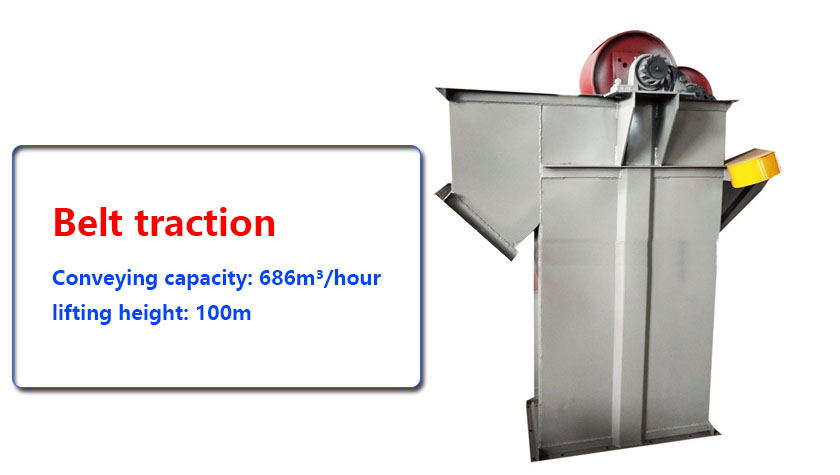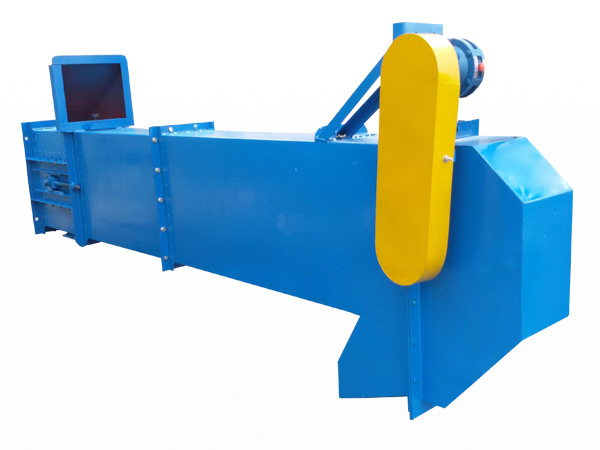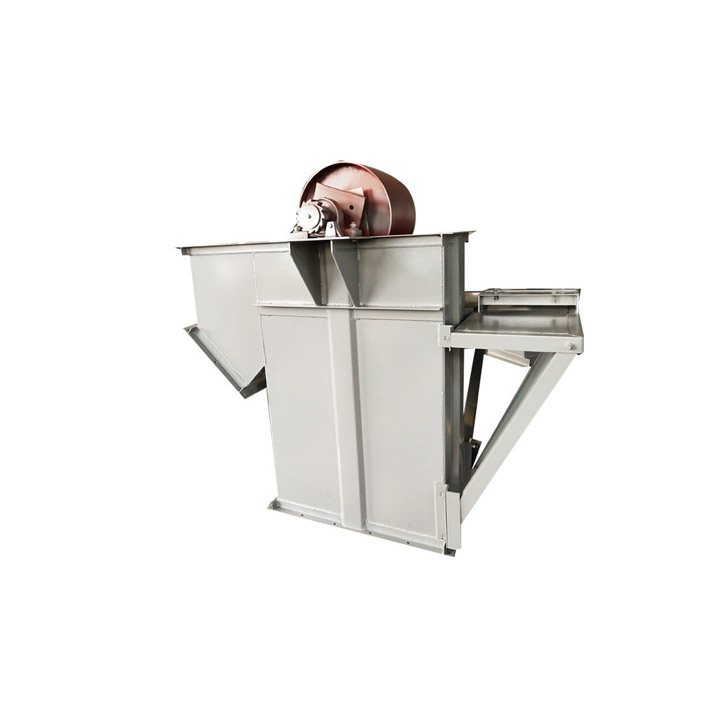
Belt Type Bucket Elevator
Belt Type Bucket Elevator -The design ensures that the material will not be spilled during feeding, lifting and unloading, and reduces mechanical wear and tear.
| Lifting height | 40m |
| Conveying capacity | 400m³/h |
| Hopper width | 160-1600 mm |
| Belt Speed | 1-2m/s |
| Material | Carbon steel/stainless steel |
What is a Belt Type Bucket Elevator?
Belt Type Bucket Elevator is a continuous mechanical device that uses a high-strength rubber belt as a traction member to transport materials vertically through a hopper fixed on the belt. Its core design concept is to achieve stable and efficient transportation of materials from low to high through the coordinated work of the belt and the hopper.
Our Belt Type Bucket Elevator uses high-quality wear-resistant belts, combined with precision-made hoppers and drive devices to ensure the stability and efficiency of materials during vertical transportation. We provide a variety of models and specifications to meet the needs of different working conditions and conveying volumes.

What are the types of belt type bucket elevators?
| Classification standard | Type | Main features | Application |
| Conveying capacity | Lightweight | Conveying volume <10m³/h, lightweight structure | Conveying light materials such as grain, flour, starch, etc. in grain, food, and pharmaceutical industries |
| Medium-sized | Conveying capacity 10-50m³/h, balanced and durable | Medium-heavy materials in building materials, chemical and other industries, such as cement, fertilizer, plastic particles, etc. | |
| Heavy-duty | Conveying capacity >50m³/h, sturdy and durable | Designed for mining, metallurgy and other industries, used to convey high-heavy materials such as ore, coal, slag, etc. | |
| Unloading method | Centrifugal | High-speed unloading, high efficiency | Dry powder or small granular materials with good fluidity |
| Gravity type | Low-speed unloading, reducing crushing | Blocky, wet or sticky materials, such as wet sand, clay, etc. | |
| Mixed type | Dual action, wide adaptability | Various industrial materials | |
| Hopper form | Deep bucket | Deep bucket, large loading capacity | Dry powdery materials |
| Shallow bucket | Shallow bucket, thorough unloading | Blocky, wet materials | |
| Pointed bottom bucket | Complete unloading, no residue | Viscous chemical products |
What are the advantages of Belt Type Bucket Elevator?
Smooth operation and low noise: Compared with chain drive, belts have better flexibility and shock absorption, run more smoothly, produce less noise, and improve the working environment.
Low maintenance cost: The belt has low lubrication requirements, relatively uniform wear, and a long replacement cycle, which reduces maintenance costs and downtime.
High conveying speed: The belt has a low dead weight and can achieve higher operating speeds, thereby improving overall conveying efficiency.
Low material breakage rate: The elastic properties of the belt reduce the impact and extrusion of the material, reducing the material breakage rate, especially suitable for the conveying of fragile materials.
High design flexibility: The belt connection method and length adjustment are relatively flexible, which can adapt to different lifting heights and installation layouts.

What is the difference between a Belt Type Bucket Elevator and a Chain Bucket Elevator?
| Comparison items | Belt bucket elevator | Chain bucket elevator | Advantage differences |
| Traction components | Rubber belt | Metal chain | Belt is lighter and softer |
| Operation speed | 1.5-3.5m/s | 0.4-1.2m/s | Belt speed is 2-3 times faster |
| Energy consumption level | Low (baseline) | 15-20% higher | Belt saves energy significantly |
| Noise level | <65dB | >75dB | Belt is quieter |
| Maintenance frequency | 1-2 inspections per year | Monthly lubrication adjustment | Easy belt maintenance |
| Service life | 5-8 years | 2-3 years | Longer belt life |
| Initial cost | Medium | Medium or slightly lower | Not much difference |
| Applicable materials | Light to moderate abrasiveness | Heavy abrasiveness | Chain is more wear-resistant |
| High temperature adaptability | ≤120℃ | ≤250℃ | Chain has higher temperature resistance |
How does the Belt Type Bucket Elevator work?
The operating mechanism of the Belt Type Bucket Elevator is based on simple mechanical principles but demonstrates excellent engineering efficiency. The motor drives the head drum to rotate through the reducer, driving the seamless rubber belt around the head and bottom drums to circulate. The hopper firmly mounted on the belt scoops the material at the bottom feeding area. As the belt rises to the head drum position, under the dual effects of centrifugal force and gravity, the material is accurately thrown to the discharge port, completing the entire lifting process. This cyclic action realizes the continuous vertical conveying of materials, and the conveying height can reach more than 50 meters, meeting the vertical conveying needs of various industrial scenarios.

Belt Type Bucket Elevator Specifications
| Model | Max Feed Size (mm) | Capacity (Ton/Hour) | Lifting Speed (m/s) | Belt Width (mm) | Lifting Height (m) |
| TD160 | 25 | 5.4-16 | 1.4 | 200 | <40 |
| TD250 | 35 | 12-35 | 1.6 | 300 | <40 |
| TD315 | 45 | 17-40 | 1.6 | 400 | <40 |
| TD400 | 55 | 24-66 | 1.8 | 500 | <40 |
| TD500 | 60 | 38-92 | 1.8 | 600 | <40 |
| TD630 | 70 | 85-142 | 2 | 700 | <40 |
What are the applications of Belt Type Bucket Elevator?
Belt Type Bucket Elevator is widely used in building materials industry (cement, limestone, sandstone, gypsum, etc.), chemical industry: (fertilizer, soda ash, resin, powdered additives, etc.), grain industry: (wheat, corn, soybean, feed, etc.), power industry (coal powder, slag, etc.), metallurgical industry (ore powder, coke, etc.), light industry (salt, sugar, starch, etc.).

How to select a belt type bucket elevator?
The selection of a belt type bucket elevator needs to consider many factors: material properties (specific gravity, particle size, humidity, abrasiveness, temperature, etc.), process requirements (conveying capacity, lifting height, inlet and outlet positions), environmental conditions (indoor/outdoor, temperature, humidity, corrosiveness) and special needs (explosion-proof, food grade, airtightness, etc.). Our engineering team has rich experience in selection and can recommend the most suitable model and configuration based on the parameters provided by the customer.
For non-standard requirements, we provide fully customized services, including the design and manufacture of special sizes, special materials, and special functions (such as weighing, iron removal, dust removal and other additional devices). Customized products usually take 4-8 weeks from design to delivery, depending on the complexity. We recommend that customers choose standard models as much as possible to obtain the best economy and delivery time, and only consider customized solutions when it is really necessary.

